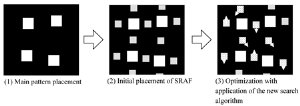Feb 15 2010
Toshiba Corporation (TOKYO: 6502) and the National Institute of Advanced Industrial Science and Technology (AIST) today announced joint development of a mask pattern optimizing technology that improves the accuracy of lithography for LSIs by approximately 20 percent. The technology opens the door to extending the life of current ArF immersion lithography to the next generation and beyond.
 Procedures for optimizing SRAF patterning
Procedures for optimizing SRAF patterning
In mask patterning, the accuracy of the resolution and critical dimensions (CD) of the main circuit patterns are enhanced by application of a sub pattern, the Sub Resolution Assist Feature (SRAF), which modulates printed images of the main pattern. Optimization of SRAF placement is becoming increasingly difficult as lithographic exposure approaches its resolution limits. The new technology applies an adaptive search algorithm based on the optimal gradient method to optimize the placement of SRAF which improves positioning and CD accuracy by approximately 20%.
Toshiba and AIST aim to bring the technology to practical use within fiscal year 2010 and will continue to seek improved results. Toshiba and AIST will unveil the new technology at the International Society for Optical Engineering (SPIE) on February 25, one of the lithography industry's leading international conferences, which will be held in San Jose, California, U.S.A., from February 21 to February 25.
Development background
Lithography using ArF laser sources has been extended to the 30-nanometer generation by application of high resolution technologies, including a phase shifting mask that employs light phase modulation and immersion lithography that uses water to increase the refractive index. However, current ArF immersion lithography is expected to reach its limit at the next generation, and the industry anticipates that lithography will transition to ArF double patterning technology, which prints images in two stages, and EUV lithography, which uses an even shorter wavelength. Toshiba and AIST together investigated how to extend the lifetime of ArF immersion lithography by improving the exposure mask.
Development overview
Methods for determining SRAF placement include a rule-based method that is based on defining the distance between SRAF and the main pattern, an interference map method that employs an optical nonlinear function, and the inverse lithography method based on inverse operation from a desired target pattern. Each has its own weaknesses; a lack of placement options, deviation from optimal placement in favour of speed, and longer processing time.
In order to overcome those weaknesses, Toshiba and AIST developed an adaptive search algorithm based on the optimal gradient method, in order to secure optimal SRAF placement. The new search algorithm carries out a local search, repeatedly seeking the best solution nearest to the current one, towards efficient achievement of an optimum solution. Application of the method enhances CD accuracy to 6nm, a 20% improvement. Used in combination with the interference map method the new technology achieves higher accuracy and higher efficiency than other methods.